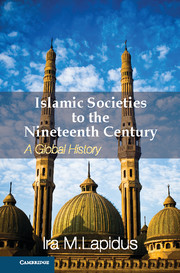Book contents
- Frontmatter
- Contents
- List of Illustrations
- List of Figures
- List of Maps
- List of Tables
- Preface
- Acknowledgments
- Acknowledgments to the first edition of A History of Islamic Societies
- Acknowledgments to the second edition of A History of Islamic Societies
- Publisher's Preface
- Introduction to Islamic Societies
- Part I The Beginnings of Islamic Civilizations
- The Middle East from c. 600 TO c. 1000
- The Preaching of Islam
- The Arab-Muslim Imperium (632–945)
- Chapter 5 Introduction to the Arab-Muslim Empires
- Chapter 6 The Arab-Muslim Conquests and the Socioeconomic Bases of Empire
- Chapter 7 Regional Developments: Economic and Social Change
- Chapter 8 The Caliphate to 750
- Chapter 9 The ʿAbbasid Empire
- Chapter 10 Decline and Fall of the ʿAbbasid Empire
- Cosmopolitan Islam: The Islam of The Imperial Elite
- Urban Islam: The Islam of Scholars and Holy Men
- Women, Families, and Communities
- Part II From Islamic Community to Islamic Society
- Part III The Global Expansion of Islam from the Seventh to the Nineteenth Centuries
- Glossary
- Bibliography
- Annotated Bibliography from A History of Islamic Societies, 2nd Edition
- Index
Chapter 7 - Regional Developments: Economic and Social Change
Published online by Cambridge University Press: 05 February 2013
- Frontmatter
- Contents
- List of Illustrations
- List of Figures
- List of Maps
- List of Tables
- Preface
- Acknowledgments
- Acknowledgments to the first edition of A History of Islamic Societies
- Acknowledgments to the second edition of A History of Islamic Societies
- Publisher's Preface
- Introduction to Islamic Societies
- Part I The Beginnings of Islamic Civilizations
- The Middle East from c. 600 TO c. 1000
- The Preaching of Islam
- The Arab-Muslim Imperium (632–945)
- Chapter 5 Introduction to the Arab-Muslim Empires
- Chapter 6 The Arab-Muslim Conquests and the Socioeconomic Bases of Empire
- Chapter 7 Regional Developments: Economic and Social Change
- Chapter 8 The Caliphate to 750
- Chapter 9 The ʿAbbasid Empire
- Chapter 10 Decline and Fall of the ʿAbbasid Empire
- Cosmopolitan Islam: The Islam of The Imperial Elite
- Urban Islam: The Islam of Scholars and Holy Men
- Women, Families, and Communities
- Part II From Islamic Community to Islamic Society
- Part III The Global Expansion of Islam from the Seventh to the Nineteenth Centuries
- Glossary
- Bibliography
- Annotated Bibliography from A History of Islamic Societies, 2nd Edition
- Index
Summary
Despite conservative intentions, the conquests, the settlement of large Arab-Muslim populations in numerous garrisons, and the consolidation of a new imperial regime set in motion vast changes in the patterns of international trade, local commerce, and agriculture. The unification of former Sasanian and Byzantine territories removed political and strategic barriers to trade and laid the foundations for a major economic revival. The Euphrates frontier between the Persian and the Roman worlds disappeared, and Transoxania, for the first time in history, was incorporated into a Middle Eastern empire. Commercial considerations inspired Arab-Muslim expansion in Inner Asia and India. Cities prospered in Iraq, Iran, and Transoxania. Basra and later Baghdad became two of the leading trading cities in the world. Samarqand, Bukhara, and Nishapur prospered. However, a new frontier was drawn between Syria and Anatolia, which had formerly been part of a single Byzantine state, and trade between these regions declined.
Each region of the new empire fared differently under Arab-Muslim rule. Some prospered, some declined. Agricultural production shifted from one area to another. Arab-Muslim landowners often replaced the previous elites. Soldiers settled on the land, and non-Arabs moved to Arab settlements. These changes created a high degree of mobility and interaction between different peoples and set the basis for the ultimate integration of populations into a shared culture.
- Type
- Chapter
- Information
- Islamic Societies to the Nineteenth CenturyA Global History, pp. 66 - 79Publisher: Cambridge University PressPrint publication year: 2012



